プラネテス
ΠΛΑΝΗΤΕΣ
Planetes
***SPOILERS***
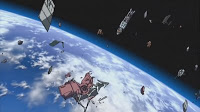 Recently, I read some articles about two satellites crashing in space and the debris they create (here, here, and here). That reminded me of the anime Planetes, which features Earth of 2075 where the main characters are members of the Debris Section of a large company, charged with collecting all of the debris in orbit of Earth. A piece of debris destroying a passenger space plane is the setup to the anime. So, I thought I’d take the time to rewatch this anime, which I really enjoyed when I first saw it in 2006, and see how it held up the second time.
Recently, I read some articles about two satellites crashing in space and the debris they create (here, here, and here). That reminded me of the anime Planetes, which features Earth of 2075 where the main characters are members of the Debris Section of a large company, charged with collecting all of the debris in orbit of Earth. A piece of debris destroying a passenger space plane is the setup to the anime. So, I thought I’d take the time to rewatch this anime, which I really enjoyed when I first saw it in 2006, and see how it held up the second time.
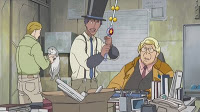 The anime, based on the four-volume manga by YUKIMURA Makoto-sensei, covers quite a bit of territory in terms of subject matter. Yes, the issue of space debris is at the heart of the series, but the series is also a parody of Japanese business practices and office politics. This aspect, which was not present in the manga, is where the series derives some humor from the Debris Section two low-level managers. The office politics also provides some means of drama as section chiefs battle to prove they are better than other section chiefs and even do things to sabotage those who aren’t “in” (such as the Debris Section’s section chief, Dolf, who’s original company was bought out and then became the Debris Section).
The anime, based on the four-volume manga by YUKIMURA Makoto-sensei, covers quite a bit of territory in terms of subject matter. Yes, the issue of space debris is at the heart of the series, but the series is also a parody of Japanese business practices and office politics. This aspect, which was not present in the manga, is where the series derives some humor from the Debris Section two low-level managers. The office politics also provides some means of drama as section chiefs battle to prove they are better than other section chiefs and even do things to sabotage those who aren’t “in” (such as the Debris Section’s section chief, Dolf, who’s original company was bought out and then became the Debris Section).
 In the midst of these two main elements of the anime, many other issues are explored such as the negative health aspects of long-term life in space (cancer from radiation), what happens when someone is born and raised on the moon, terrorism (especially in space), the unintended consequences of getting off of crude oil as an energy source, the opposition to other forms of energy no matter what they come from (leading to environmental terrorism), the corrupt nature of the political organization International Treaty Organization (INTO), the value of continued space exploration (with the launch of the Jupiter mission ship, Von Braun) and the complaints about the rich getting richer and the poor getting poorer.
In the midst of these two main elements of the anime, many other issues are explored such as the negative health aspects of long-term life in space (cancer from radiation), what happens when someone is born and raised on the moon, terrorism (especially in space), the unintended consequences of getting off of crude oil as an energy source, the opposition to other forms of energy no matter what they come from (leading to environmental terrorism), the corrupt nature of the political organization International Treaty Organization (INTO), the value of continued space exploration (with the launch of the Jupiter mission ship, Von Braun) and the complaints about the rich getting richer and the poor getting poorer.
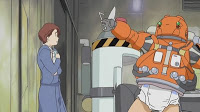 The story starts with the debris collection and some lighter stuff, but also has the main female character, TANABE Ai, show herself to be very naive and preachy. So for the first few episodes, the audience has to deal with her adjustment to the realities of working in space versus the idealistic dream she had. After that, the other elements are blended in portraying what comes off as a very believable future — no mecha, no blasters, but technology that seems right. This
The story starts with the debris collection and some lighter stuff, but also has the main female character, TANABE Ai, show herself to be very naive and preachy. So for the first few episodes, the audience has to deal with her adjustment to the realities of working in space versus the idealistic dream she had. After that, the other elements are blended in portraying what comes off as a very believable future — no mecha, no blasters, but technology that seems right. This 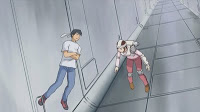 is added to by having space shots not have sound (save for the sounds of voices on the radio, or the noises that one might hear in an EVA suit), have the areas of the space station not under centrifugal force (artificial gravity) float (and learn to travel in weightlessness), have people shown to move easier with the lighter gravity of the moon, etc. These were excellent touches that improves the enjoyability of the anime.
is added to by having space shots not have sound (save for the sounds of voices on the radio, or the noises that one might hear in an EVA suit), have the areas of the space station not under centrifugal force (artificial gravity) float (and learn to travel in weightlessness), have people shown to move easier with the lighter gravity of the moon, etc. These were excellent touches that improves the enjoyability of the anime.
 The first half of the series focuses on the debris collection and office politics mostly with some moments of the terrorist group Space Defense Force. Also, the romance between the male lead, Hachi, and Ai begins. The second half of the anime shifts focus to the building of the Jupiter exploration ship Von Braun, where Hachi decides to follow a dream and go through the rigorous weeding out process to reduce 20,000 applicants to 18. During this part, the Space Defense Force steps up its activities and the relationship between Ai and Hachi is somewhat strained by Hachi’s single-minded determination to become a member of the crew which means ignoring Ai. However, all story elements are resolved nicely and it was a joy to watch.
The first half of the series focuses on the debris collection and office politics mostly with some moments of the terrorist group Space Defense Force. Also, the romance between the male lead, Hachi, and Ai begins. The second half of the anime shifts focus to the building of the Jupiter exploration ship Von Braun, where Hachi decides to follow a dream and go through the rigorous weeding out process to reduce 20,000 applicants to 18. During this part, the Space Defense Force steps up its activities and the relationship between Ai and Hachi is somewhat strained by Hachi’s single-minded determination to become a member of the crew which means ignoring Ai. However, all story elements are resolved nicely and it was a joy to watch.
 What makes this anime so interesting is how the writers basically took three volumes of manga (maybe a bit of volume 4) and turned it into a 26-episode anime. Frankly, I find the anime to be one of the rare exceptions where it uses the core of the source manga and makes something new but better (but with similar themes). All of the Japanese business and office politic stuff (and characters) are anime-only elements, so they are a bit rougher in the beginning, but blend in quite well by the anime’s end. There are other characters which only appear in the anime, such as Claire, but are worked pretty well to advance the overall themes and plot.
What makes this anime so interesting is how the writers basically took three volumes of manga (maybe a bit of volume 4) and turned it into a 26-episode anime. Frankly, I find the anime to be one of the rare exceptions where it uses the core of the source manga and makes something new but better (but with similar themes). All of the Japanese business and office politic stuff (and characters) are anime-only elements, so they are a bit rougher in the beginning, but blend in quite well by the anime’s end. There are other characters which only appear in the anime, such as Claire, but are worked pretty well to advance the overall themes and plot.
 The anime did not include elements such as Toy Box captain Fee joining an anti-war movement on Earth after Hachi joins the Von Braun crew, Hachi’s dreams that feature an alien apparently talking to him, “The Baron,” who joins the Debris Section to replace Hachi and who claims to be an alien, Fee’s attempt at a life as a mother and housewife, and the Von Braun’s arrival at Jupiter, where Hachi ends up having to make the speech. To be honest, most of these elements were things I didn’t much care for in the manga. I would have liked to have seen Hachi get to Jupiter though. The one thing that the anime SORELY missed is the exploration of Ai’s family. In the manga, that’s where Hachi proposes to Ai — at her parent’s home. Oh well.
The anime did not include elements such as Toy Box captain Fee joining an anti-war movement on Earth after Hachi joins the Von Braun crew, Hachi’s dreams that feature an alien apparently talking to him, “The Baron,” who joins the Debris Section to replace Hachi and who claims to be an alien, Fee’s attempt at a life as a mother and housewife, and the Von Braun’s arrival at Jupiter, where Hachi ends up having to make the speech. To be honest, most of these elements were things I didn’t much care for in the manga. I would have liked to have seen Hachi get to Jupiter though. The one thing that the anime SORELY missed is the exploration of Ai’s family. In the manga, that’s where Hachi proposes to Ai — at her parent’s home. Oh well.
 As to the DVD set, there are lots of extras from Bandai which are very enjoyable. The subtitles make use of the Japanese honorifics “senpai” and “sensei,” but most of the others are dropped. There is an instance where a male character is given a “-chan” honorific and it survives, which is strange because the person using the honorific addresses all of his people, male or female, with the “-chan” honorific. Oh well. I will say that the lack of honorifics in the subtitles removes a clue that the Japanese provide regarding Nono-chan.
As to the DVD set, there are lots of extras from Bandai which are very enjoyable. The subtitles make use of the Japanese honorifics “senpai” and “sensei,” but most of the others are dropped. There is an instance where a male character is given a “-chan” honorific and it survives, which is strange because the person using the honorific addresses all of his people, male or female, with the “-chan” honorific. Oh well. I will say that the lack of honorifics in the subtitles removes a clue that the Japanese provide regarding Nono-chan.
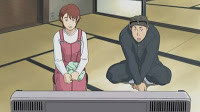 In the end, the anime writers create an adaptation of the manga which makes many changes to the original story but retains many core elements and end up creating something that is (for the most part) much better than the original anime. The production values in animation are excellent to give things a feeling of really being in space and the direction and overall writing are pretty solid. As such, if you haven’t at least watched this anime, I highly recommend it.
In the end, the anime writers create an adaptation of the manga which makes many changes to the original story but retains many core elements and end up creating something that is (for the most part) much better than the original anime. The production values in animation are excellent to give things a feeling of really being in space and the direction and overall writing are pretty solid. As such, if you haven’t at least watched this anime, I highly recommend it.
Note: my original review can be found –> HERE for those interested.



 February 27th, 2009
February 27th, 2009  AstroNerdBoy
AstroNerdBoy  Posted in
Posted in  Tags:
Tags: 